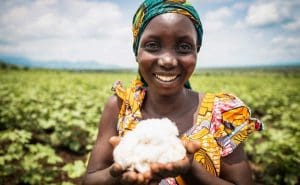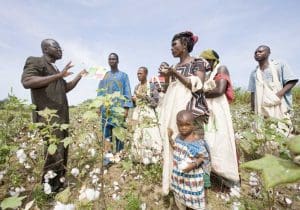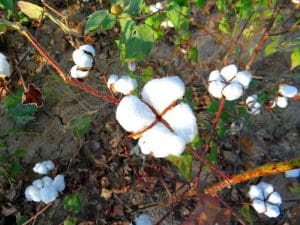According to a new white paper published by a Textile Exchange Pan-Africa Sourcing Working Group titled -“‘Cotton in Africa: Sustainability at a Crossroads’, an increasing number of countries in Africa are choosing to adopt genetically modified (GM) cotton, defined as cotton that has had its genetic material (DNA) altered in a manner that does not occur naturally.
‘Cotton in Africa: Sustainability at a Crossroads’, reveals that seven out of Africa’s 54 countries currently allow GM cotton crops, while four do not permit them to be grown. The white paper outlines the risks of scaling GM cotton in Africa and the opportunities of organic and GM-free preferred cotton standards such as Organic, Fairtrade, and Cotton made in Africa (CmiA) preferred cotton production, and concerns about GM technology. It also requested to policy makes to set rules that prohibit genetic modification and spread awareness to industry and consumers regarding the production process that involves the hazardous effect to environment.

In 1997 South Africa started the use of GM cotton slowly on small landmass and after 11 years it is adopted by Burkina Faso (Burkina Faso has since suspended its approval) and Eswatini and Sudan in 2012.
In 2018 another four countries – Nigeria, Ethiopia, Kenya, and Malawi – approved the use of GM cotton and Eswatini started growing the crop. In 2020, Kenya planted GM cotton for the first time commercially. However, in Africa some parts of Africa such as Algeria, Burkina Faso, Egypt, and Madagascar prohibited or have opted out of genetic modification in general, or GM cotton specifically.
With the increasing pressure from consumers and NGOs, as well as there is increasing interest from within the textile industry, to set commitments for sourcing more sustainably grown cotton as evidenced by the textile industry‘s involvement in the 2025 Sustainable Cotton Challenge and other initiatives. Leading designers, manufacturers, and retailers are increasingly making commitments to use more organic cotton as they develop their sustainability strategies, often focused on climate change mitigation. In this way, they are supporting the more than 182,000 farmers growing organic cotton worldwide – including the more than 36,000 in Africa.
These companies also are looking into becoming certified to finished product standards such as Textile Exchange‘s Organic Content Standard as well as the Global Organic Textile Standard, which prohibits the use of GM cotton.

CEO and Founder of Mantis World and Chair of the Pan-Africa Sourcing Working Group, Prama Bhardwaj, urges African cotton producers to “choose to grow organic cotton which can be integrated into the growing African sustainable textile supply chain or used by manufacturers in Europe and the Middle East,“ all of which are striving to meet United Nations Sustainable Development Goals addressing responsible production as well as industry commitments.
Global production of organic cotton saw continuous increment for the period 2016-17 to 2017-18, increasing 56 per cent to 180,971 metric tonnes (831,193 bales) out of which Africa accounted for approx. 4 Per Cen showed 20 per cent increase over 2016-17. Tanzania is the largest organic cotton producing country on the landmass, followed by Uganda, Benin, Burkina Faso, Mali, Egypt, Ethiopia, and Senegal. Approximately 37,000 farmers in eight countries grow organic cotton.

Today, Africa is at a crossroads. Textile Exchange‘s Pan-Africa Sourcing Working Group urges policymakers and the textile industry to take a path toward resilient and healthy rural communities and capitalize on the growing demand for preferred cotton production and manufacturing. The time and place are ripe.
Textile Exchange‘s Pan-Africa Sourcing Working Group supports and encourages the growth of organic and preferred cotton programs (such as Fair Trade and Cotton made in Africa) that prohibit the use of genetic modification. These programs also embrace practices that build organic matter in soils (increasing carbon sequestration), support smallholder farmers, and protect human health and the environment.
To reduce the impact of using MG cotton on global climate and key to expanding preferred cotton production and manufacturing is creating institutions, networks, and the related infrastructure by governments, industry, farmers, civil society organizations, foundations that come together with a common goal. This includes having organizations funded and in place that can organize and train the farmers and manage internal control systems, among other roles. Until these additional needs in management capacity and technical expertise are addressed, increased demand will not automatically translate into increased production.
Textile Exchange has released its second annual report on progress towards its 2025 Sustainable Cotton Challenge which aims to spur a shift in the market towards the use of more sustainable cotton.
The 2025 Sustainable Cotton Challenge aims to encourage brands and retailers to commit to source 100 per cent of their cotton from the most sustainable sources by the year 2025.
This second annual progress report reveals that 27.5 per cent of signatories have already achieved their target of 100 per cent preferred cotton usage by 2025, and another 27.5 per cent have achieved a 75-99 per cent preferred cotton share. Some 80 per cent are at least halfway to meeting the target.
With increased production and vertical integration, Africa has the potential to become a significant hub for ethical and sustainable textile-based development. There are numerous benefits to sourcing organic cotton and GM-free preferred cotton from the landmass.

